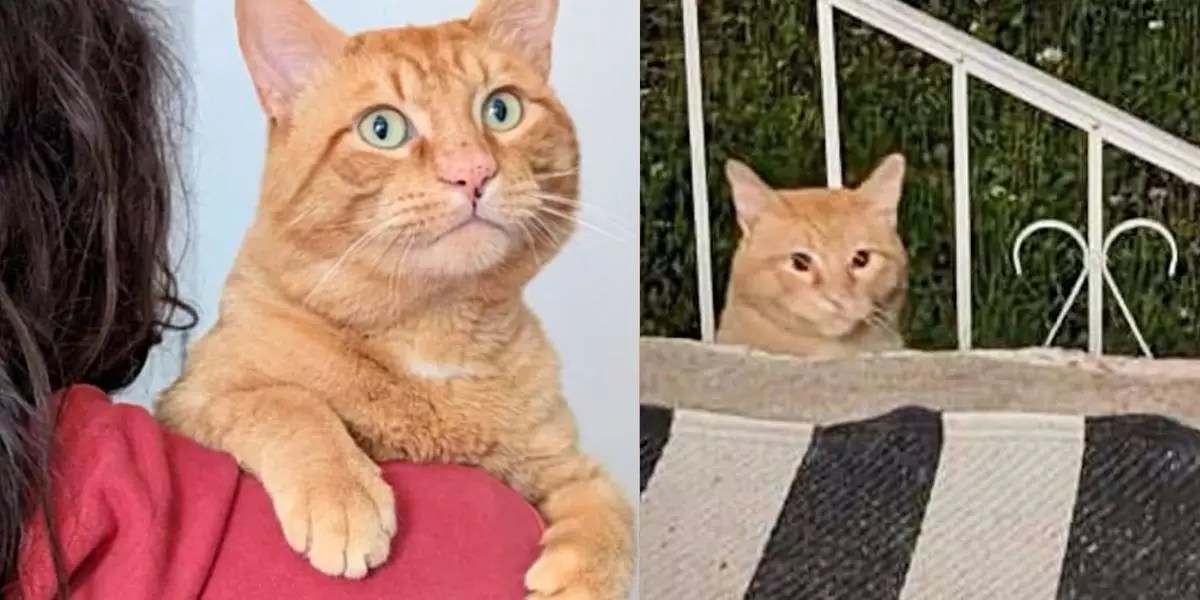In the quiet solitude of a Montreal neighborhood, an unnoticed figure lurked in the shadows—an orange tabby whose life had been marked by hardship and survival. His initial appearance was unassuming; driven by hunger, he sought refuge at a family’s porch, hoping for a morsel to quell his relentless craving. This moment, seemingly ordinary, concealed the beginning of a remarkable transformation. It exposes the often overlooked plight of street cats—creatures resilient yet vulnerable, yearning for kindness amidst societal indifference. His daily visits became a ritual, a testament to the power of compassion rooted in consistent care. The family’s quiet dedication highlights a broader lesson: small acts of kindness can peel back layers of suffering, revealing a creature capable of hope and connection.
From Fear to Trust: The Power of Persistent Compassion
Initially, the feline’s wary retreat into the shadows exemplifies the deep scars—both physical and emotional—imbued in outdoor life. His retreat reflected a survival instinct molded by years of uncertainty. Yet, the family’s unwavering commitment to feeding and observing him began to erode his defenses. Each day, their routine of leaving food and water fostered a fragile bond—one that blossomed in subtle signs of curiosity and comfort. Over time, the cat’s boldness grew; he no longer fled at the sight of humans but instead lingered, quietly observing from a safe distance. This evolution underscores a critical insight: patience and consistency can unlock trust in even the most cautious souls. Their dedication transformed a wary outsider into a curious companion, demonstrating that persistence can bridge the chasm of fear.
A Second Chance: Embracing a New Life Indoors
One rainy evening, nature’s elements collaborated with the family’s kindness to culminate in a life-altering moment. Soaking wet and exposed to the elements, the cat’s vulnerability reached a breaking point. When the door swung open, he stepped inside, surrendering to the warmth and safety that had long been denied him. This pivotal act of acceptance shifted his trajectory from the street to the sanctuary of a home. The transition from outdoor survivalist to indoor companion is emblematic of hope’s transformative influence; it embodies how compassion can rewrite a narrative of hardship into one of affection and security. His physical scars, once symbols of hardship, now serve as testament to his resilience and the healing power of love. This rescue story challenges us all to see beyond scars and hunger, recognizing the innate worth and potential for happiness that every creature possesses.
The Heart of a Fighter, The Spirit of a Kitten
In a new environment, Julep—rebuilt through kindness—displays unrelenting enthusiasm and an insatiable curiosity. Despite being around four years old, his youthful spirit persists vibrantly. His vocal nature and playful antics reveal an inner kitten eager to explore and connect. His affectionate behaviors—rolling onto his back, nuzzling, and greeting with a chorus of purrs—are manifestations of trust and contentment. Yet, beneath his playful exterior lie the visible scars of a life roughened by outdoor dangers. His story reminds us that resilience often bears physical reminders, but it’s the spirit within that truly defines an individual. Julep’s journey from street to sanctuary is not just about survival; it’s an ode to the transformative power of community and love. It confronts us with the truth that emotional scars may fade, but the capacity for joy and connection remains unhindered when kindness guides the way.
Reimagining Responsibility: The Role of Rescue Organizations
The ongoing care by organizations like Chatons Orphelins Montreal exemplifies structured compassion—rescue, medical treatment, and foster care conjoined to ensure a full recovery. Their involvement underscores the importance of organized efforts in animal welfare; they serve as catalysts that turn individual acts of kindness into systemic change. However, the true hero lies in the everyday people who recognize the value of each life and take tangible steps to champion it. Julep’s story powerful advocates for community responsibility, emphasizing that urban environments can be battlegrounds of hope rather than despair when collective efforts coalesce. This narrative challenges us to see rescue not as a one-time act, but as an ongoing commitment—a moral obligation to those who cannot speak for themselves. It is a call for all of us to consider how many unnoticed lives could be rewritten through simple acts of kindness and attentive care.
In essence, Julep’s journey from a starving stray to a cherished pet is a testament to the profound impact of sustained compassion, patience, and community effort. It invites us all to look beyond appearances and circumstances, recognizing the potential for renewal residing within even the most battered of souls. When given a chance, hope can illuminate the darkest corners—transforming despair into a beautiful story of second chances.
